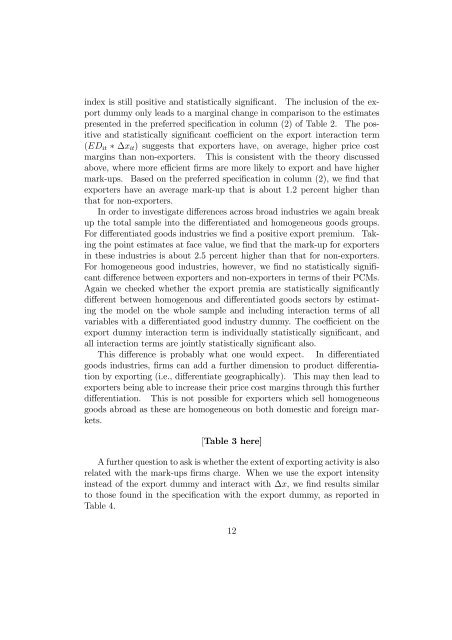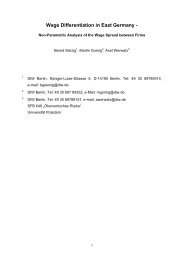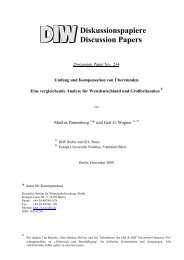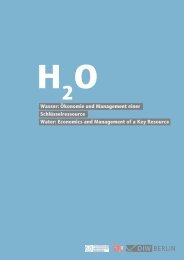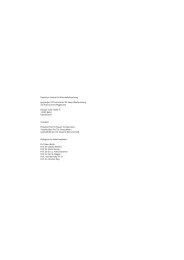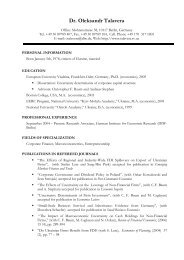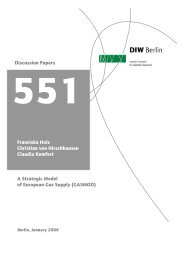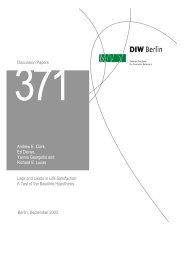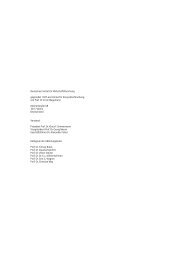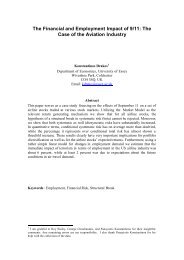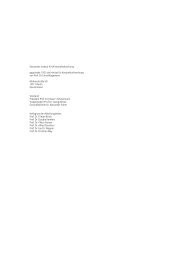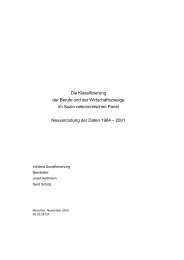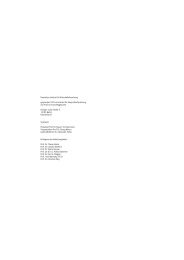Holger Görg and Frederic Warzynski Price cost margins ... - DIW Berlin
Holger Görg and Frederic Warzynski Price cost margins ... - DIW Berlin
Holger Görg and Frederic Warzynski Price cost margins ... - DIW Berlin
You also want an ePaper? Increase the reach of your titles
YUMPU automatically turns print PDFs into web optimized ePapers that Google loves.
index is still positive <strong>and</strong> statistically significant. The inclusion of the export<br />
dummy only leads to a marginal changeincomparisontotheestimates<br />
presented in the preferred specification in column (2) of Table 2. The positive<br />
<strong>and</strong> statistically significant coefficient on the export interaction term<br />
(EDit ∗ ∆xit) suggests that exporters have, on average, higher price <strong>cost</strong><br />
<strong>margins</strong> than non-exporters. This is consistent with the theory discussed<br />
above,wheremoreefficient firms are more likely to export <strong>and</strong> have higher<br />
mark-ups. Based on the preferred specification in column (2), we find that<br />
exporters have an average mark-up that is about 1.2 percent higher than<br />
that for non-exporters.<br />
In order to investigate differences across broad industries we again break<br />
up the total sample into the differentiated <strong>and</strong> homogeneous goods groups.<br />
For differentiated goods industries we find a positive export premium. Taking<br />
the point estimates at face value, we find that the mark-up for exporters<br />
in these industries is about 2.5 percent higher than that for non-exporters.<br />
For homogeneous good industries, however, we find no statistically significant<br />
difference between exporters <strong>and</strong> non-exporters in terms of their PCMs.<br />
Again we checked whether the export premia are statistically significantly<br />
different between homogenous <strong>and</strong> differentiated goods sectors by estimating<br />
the model on the whole sample <strong>and</strong> including interaction terms of all<br />
variables with a differentiated good industry dummy. The coefficient on the<br />
export dummy interaction term is individually statistically significant, <strong>and</strong><br />
all interaction terms are jointly statistically significant also.<br />
This difference is probably what one would expect. In differentiated<br />
goods industries, firms can add a further dimension to product differentiation<br />
by exporting (i.e., differentiate geographically). This may then lead to<br />
exporters being able to increase their price <strong>cost</strong> <strong>margins</strong> through this further<br />
differentiation. This is not possible for exporters which sell homogeneous<br />
goods abroad as these are homogeneous on both domestic <strong>and</strong> foreign markets.<br />
[Table 3 here]<br />
A further question to ask is whether the extent of exporting activity is also<br />
related with the mark-ups firms charge. When we use the export intensity<br />
instead of the export dummy <strong>and</strong> interact with ∆x, wefind results similar<br />
to those found in the specification with the export dummy, as reported in<br />
Table 4.<br />
12


